Become a seven-person mass extinction event, and mash the a button until nothing moves.
Type: Single-player
Genre: RPG
Developer: Silver Lemur Games
Publisher: Pineapple Works
Release date: 20 April, 2020

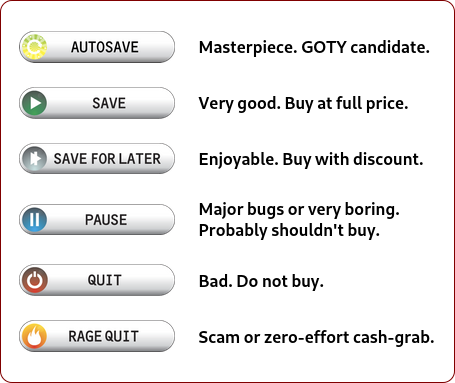
Intro
Legends of Amberland: The Forgotten Crown (or just “Amberland” from now on) strongly sells itself upon being “inspired by 90’s western RPGs”, by which they mean “trying to recreate Might and Magic”.
This review is for the Switch port in particular, but the game seems to be largely the same as the PC versions. (The Ranger was renamed to Paladin for some reason, but that seems to be the largest difference I can get at a glance.) Because the Switch is heavily restricted in how it will officially allow uploads, all my screenshots had to be uploaded to Twitter as an intermediary, so please forgive the terrible JPG compression artifacts, but I’ll try to see if linking the animated images might make up for that.
Retro Inspiration
So as mentioned in the intro, the game is basically just trying to clone Might and Magic, and more specifically Might and Magic 3 through 5. The game clearly lacks the later 90’s Might and Magic 6 and 7’s more free-roaming real-time elements, and advertises itself as such.
I was personally never a big fan of the Might and Magic series as a kid, preferring the top-down approach of games like the “Gold Box” D&D games followed up by Baldur’s Gate, or top-down tactical sci-fi games like The Mars Saga which by the end of the 90s would have Fallout as its champion. The “classic” wizardry-style first person combat, especially when they started to become real time, demanding fast clicks while scrolling through wizard spell lists just turned me off in comparison to the more deliberate top-down grid-based style.
With that said, I’ve recently come around to the classic Wizardry style of first-person combat with fixed party formations due to the existence of games like Etrian Odyssey on handhelds. I’ll discuss this more in a later section, but the simpler gameplay and fighting in the same “screen mode” as exploration mean that the combat can also go much more quickly.
One thing notable about Amberland in comparison to Might and Magic, however, is that there is no Thief/Rogue class. There are no trapped chests, no locked doors, no secret doors, no dungeon hazards that turn off the lights or spin you around, no warp points, no puzzles more complicated than “you have to throw a switch to open a door”. There are damage traps, but they’re basically unavoidable.
This is a game that advertises that it is an improvement over the 90’s era games because of its “simplistic, fast-paced combat”… well, yes, because this game goes at the speed of your button presses, you can explore these mostly barren dungeons very quickly once you’ve gotten used to it and stopped caring about selecting spells…
This simplistic (their word, not mine) gameplay is helped by removing all ranged combat, all ability to use stealth or environments or positioning or anything to help you besides raw combat stats. You might as well face north at all times and move purely based upon looking at the map even if it means charging enemies rearwards, because there’s no combat disadvantage to having enemies sneak up on you!
Porting and Interface
There aren’t many controls in Amberland, although there are enough to require the use of the “zL” key (left trigger/L2 on other console controllers) as a switch in what other buttons will do. For example, “X” is rest while out of combat, and “zL+X” opens the magic screen. The magic screen is used far more often than the rest screen, so I am partially annoyed at that, but “zL+X” is also what opens the magic screen in combat, so I suppose they are prioritizing consistency over economy.
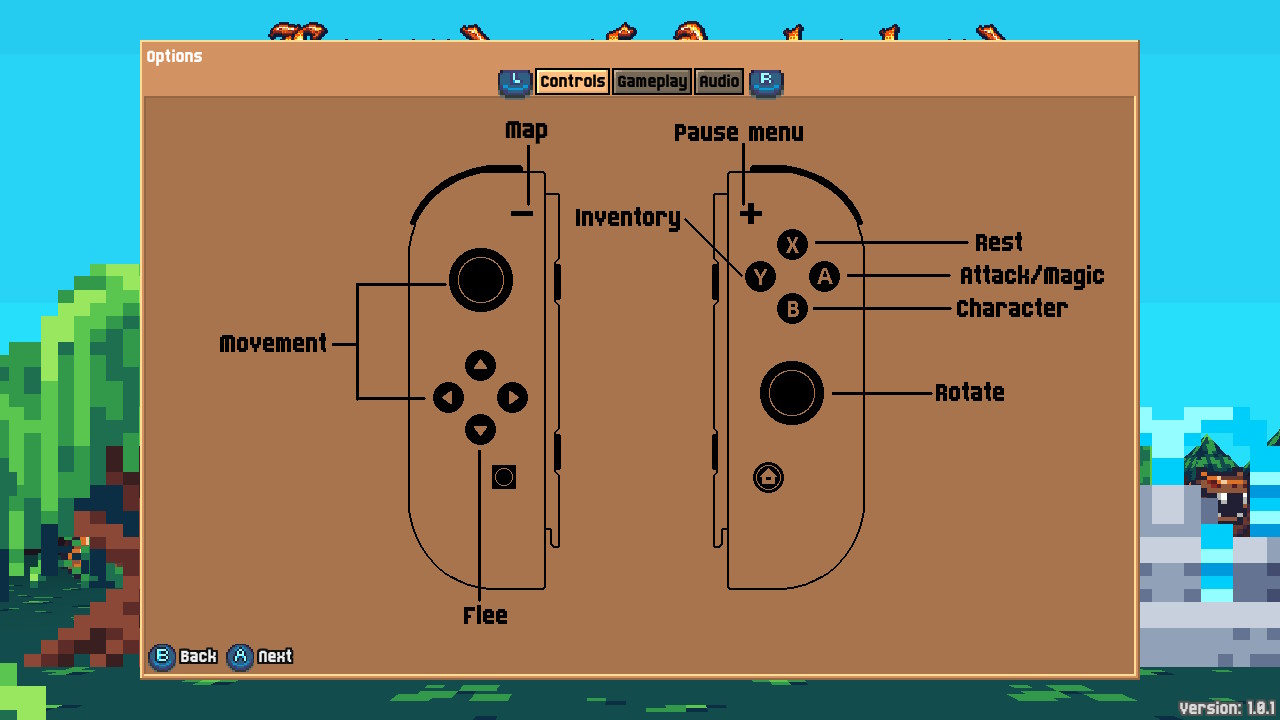
At any time, the “zR” button can be used to show tooltips on most things on the screen, as well as what buttons perform what functions.
When looking at the game screen, you’ll notice that there are buttons for everything on the right side of the screen, including movement, just like ye olde mouse-based exploration RPGs. This is a purely vestigial structure from the game’s PC version for mouse controls, but I suppose they had nothing else in the interface to fill up that space, so they just left it all there as it stands.
By and large, my biggest complaint about the interface is merely that too many of the most-often used commands are “zL+whatever”, while rarely-used commands fill up the ones that don’t take holding down a second button, and that the save menu doesn’t remember where you last saved, pointing to save slot 1 by default every time. (Don’t overwrite your spouse’s/SO’s/sibling’s save file by mistake!)
Another major issue, however, is that there is no numeric display of your stats unless you look in the character or magic menu, just a (pixelated) bar. After a few levelups, I have no real handle on what my max HP or MP is after a while. My healing spells just move the red bar up less as time goes on…
You also move left/right when pressing left/right on the left stick or d-pad, and need to use either the L and R buttons to turn or else use the right stick (which uses the thumb you need on all the other command buttons) solely to turn. It’s not really as natural as the L or R to move sideways options most games have, and I’d appreciate an option to switch the interface.
For those playing on the PC, I looked it up, and the game does have a proper key rebinding menu.
Party Building
One of the other things Amberland had advertised in the bullet points is its “extensive character customization.” Protip: Any time a CRPG advertises it has character customization, and it’s not showing you the ability to completely remake your character’s appearance or something else drastic, it’s a bit of a red flag they don’t have anything better to advertise.
As advertised, you get seven characters in a party. They must be selected at the start of the game, and there is absolutely no opportunity to change any selections you make other than to restart the whole game from the beginning.
The middle three slots of the seven party slots are the “frontline”, and nearly all damage will go to them. Attacks only hit the side characters (“left flank” and “right flank”) in attacks that hit the whole party or a rare type of attack that hits one target and both characters to either side of them. This means the first and seventh slots are basically only ever attacked by whole-party attacks that either inflict less damage, have wildly lower chances of hitting, or are used by boss monsters like dragons that are pretty much meant to wipe parties below a certain level in one shot.
Each character consists of a race, a sub-race, a class, and the distribution of a few free character points to the five stats.
Races apply a few stat changes and how quickly you gain experience (even though it only lists + or – 5%, this adds up to over a full level by late-game), as well as gives access to a couple of race-specific variant classes. Sub-races apply three minor bonuses, generally in the form of +1 to a stat every X number of levels or +1 HP or MP per level, although a few get an immunity to specific status ailments.
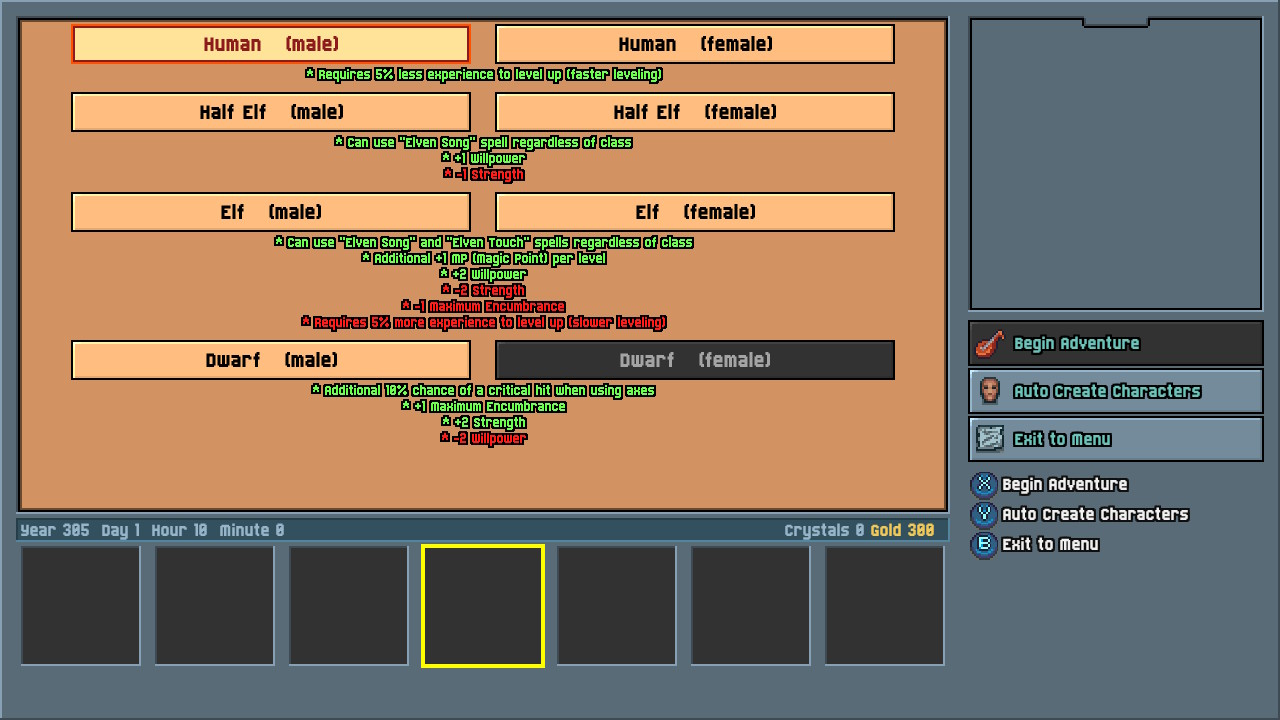
Classes are the most character-defining choice. These are generally broken down into martial classes, magic classes (which are divided into either clerics or wizards), and hybrid classes.
Warriors are the most pure fighter types that get the most HP and deal the most damage, while having no magic whatsoever. You will glue the basic attack button to them, and they will spam it. Because magic is severely underpowered in this game, warriors will wind up doing twice as much damage as anyone else but the knights, so you absolutely should take two of these guys.
Knights are warriors who gave away HP and damage for more “encumbrance”, which is the ability to carry heavier armor. They’re a gamble that better armor will let them tank more. You absolutely must have one in your center slot, or you might as well restart.
Wizards are magic-users that focus almost entirely upon buffs and offensive magic because this game isn’t complex enough to have utility magic that does anything. They can deal more damage in the early game, but the game features a very rigid spell system where spells deal fixed damage at various levels of “mastery” from the derived “Arcane” stat based upon your Knowledge stat. New spells can only be learned around levels 10, 20, 30, and 40, so a new spell at fourth or fifth level mastery can be very powerful, but it never gets any better after fifth rank mastery, forcing you to go with less and less MP-efficient spells. Eventually, it makes more sense for the wizard to just bap a monster on the nose with their staff than cast magic because it’s dealing more damage than any spell that won’t cost a tenth of their MP pool. That said, some of their buffs are absolutely mandatory late-game, so you have to lug someone with wizard spells around (although consider the Elven racial class Magic-Knight, as they supposedly get the same buffs). Shove them in the first or seventh slot where they take the least possible damage.
Healers are the healing class that unfortunately went to Final Fantasy-style “White Mage” school of sitting in the back row doing nothing but heal spam instead of the cool kid’s D&D school of beating people with a mace or casting Hold Person to actually help win battles. You absolutely need mid-battle healing, so you’ll almost certainly need to take one and shove them in the first or seventh slot where they don’t take damage.
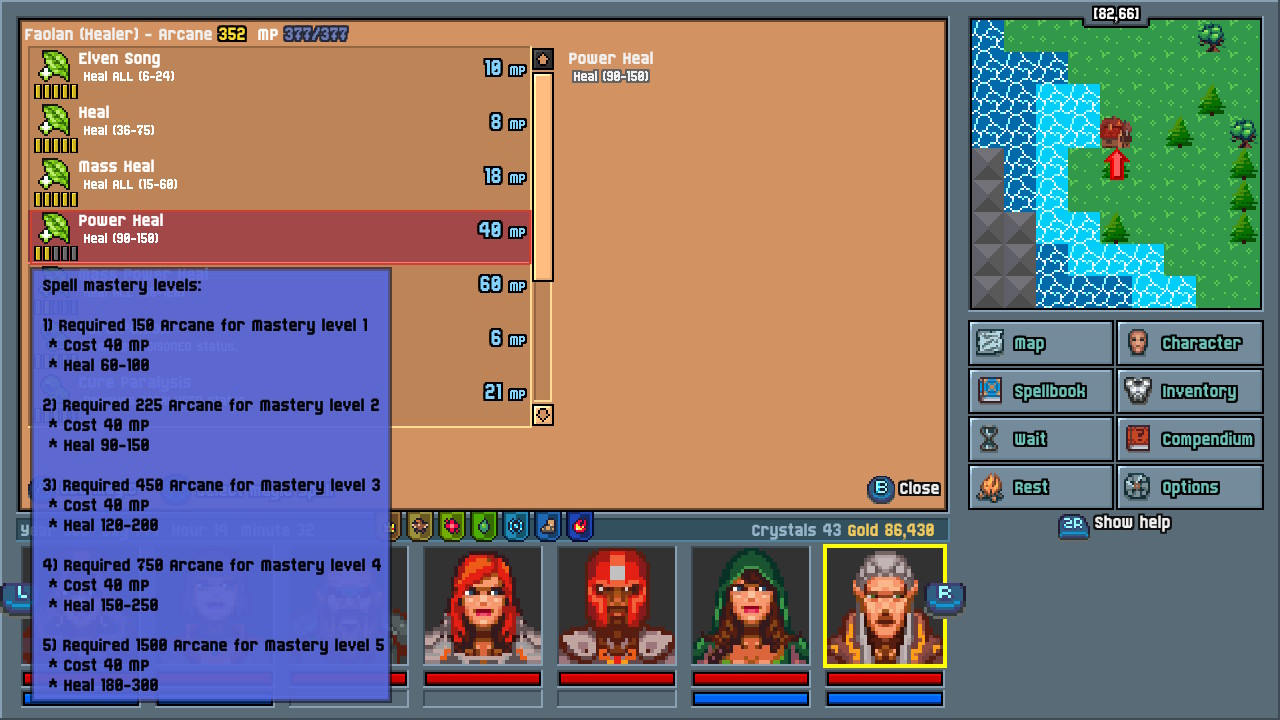
Bards are hybrid fighter-healers that get their own brand of buff spells and are the only ones to heal certain status ailments like fear. They die slightly less rapidly than healers under abuse and if you don’t need another heal spell to save a warrior at the moment, they inflict marginally more damage with their shortswords, but they do this at the cost of having significantly worse “Arcane” that lets you use MP efficiently, so they tend to be either poor healers or terrible fighters depending on where you allocate stats.
Paladins (or Rangers if you play on PC) are fighter-wizards that give up most of their ability to survive hits for crap magic that never stacks up even to their weakened melee abilities, generally just making them inferior warriors. I did not take one on my main game, so I never leveled one up to know what powers they get specifically, but apparently they get the “sharpness” buff that increases damage output for all allies. (Something I needed to play another game to find out because there is no way to know without investing a few hours of playtime to find out…)
I don’t know because there’s no guide anywhere telling you what the spell list is for the character classes in a game where you are forced to keep any classes you take for the whole game. Good luck with experimenting on a class whose powers you won’t know until 2/3rds of the way through the game and requires restarting to try a different class out!
Racial classes add some flavor of twist to an existing class. A couple, such as Champion and Troll Slayer are specialized fighters that are generally weaker, yet are stronger against specific monster types that therefore are useless because those aren’t important monster types. Troubadour is a bard that gets a few spells slightly earlier in exchange for getting critically important mass heal spells never. Battlesmith is a paladin with more fighter and less magic, which makes them suck significantly less and almost be viable on the frontline. Magic-knight is apparently able to cast all the wizard’s buffs while also being a fighter, making them much better at doing the paladin’s job, and able to take over on buffing for the wizard, which means it’s OK to take the last class. Finally, the Sage is an elven wizard that gives up buff spells for healing magic, making them able to be a supplemental healer when you need every Mass Power Heal you can get to survive dragon fire.
Finally, you have five basic attributes that are basically D&D’s stats minus Charisma because haha, like we’re letting you do anything but kick in the door around here! Strength lets you carry more and deal more damage. Toughness gives you more HP so you don’t die in one hit. Dexterity ups hit and evade rates, so fighters need to spend a little here to not waste turns missing. Knowledge is mainly for spellcasters to raise Arcane so they can go up mastery levels in spells. Willpower is mainly for more MP, but also reduces magic damage. Knowledge hypothetically can help fighters by raising their crit chance, but I never tried it, and willpower hypothetically is useful for reducing sorcerer damage, but you know what else stops sorcerer from damaging you? Being strong enough to gut them in one shot.
The end result is that your “extensive character customization” generally amounts to “pick one of the tiny handful of working party types we built the game for you to use or be wrong and suffer until you restart and play like we tell you.”
This isn’t terribly different from the true experimental days of the CRPG, where there were often several semi-useless skills and a few skills that were so overpowered they broke the game, but there was something charming about that lack of game balance that I find missing in a lot of modern “streamlined” games that think the best way to offer players a choice is to not give them a choice at all. I often did put at least some points into the useless skills when I could get away with it, and could feel like there was some value in the Streetwise skill even if weapon skills were all-important. Even if whatever game feature used those skills were shallow and beside the point, the game was better for having them rather than having an utterly monotonous “combat or go play another game” system.
Basic Gameplay
You start the game dumped in a field with a goblin about one turn away from attacking you. You gain experience and gold from killing things and new items and gold from opening chests. The game features the premise of an open world, although that really doesn’t mean much in practice, as I’ll explain in the next section. Your path to the next area is blocked by a beefgate monster, so your only option is to mow down goblins and vacuum up treasure from the nearby caves because you have nothing better to do.
Monsters do not respawn in this game, and neither do the chests or any other content. When you kill something, it is gone forever. This also means there’s a finite amount of EXP and GP to gain in the game. This means the game starts off overflowing with monsters, but by the end of it, you’ve genocided literally everything that moves in your voracious appetite for even the slightest shred of xp.
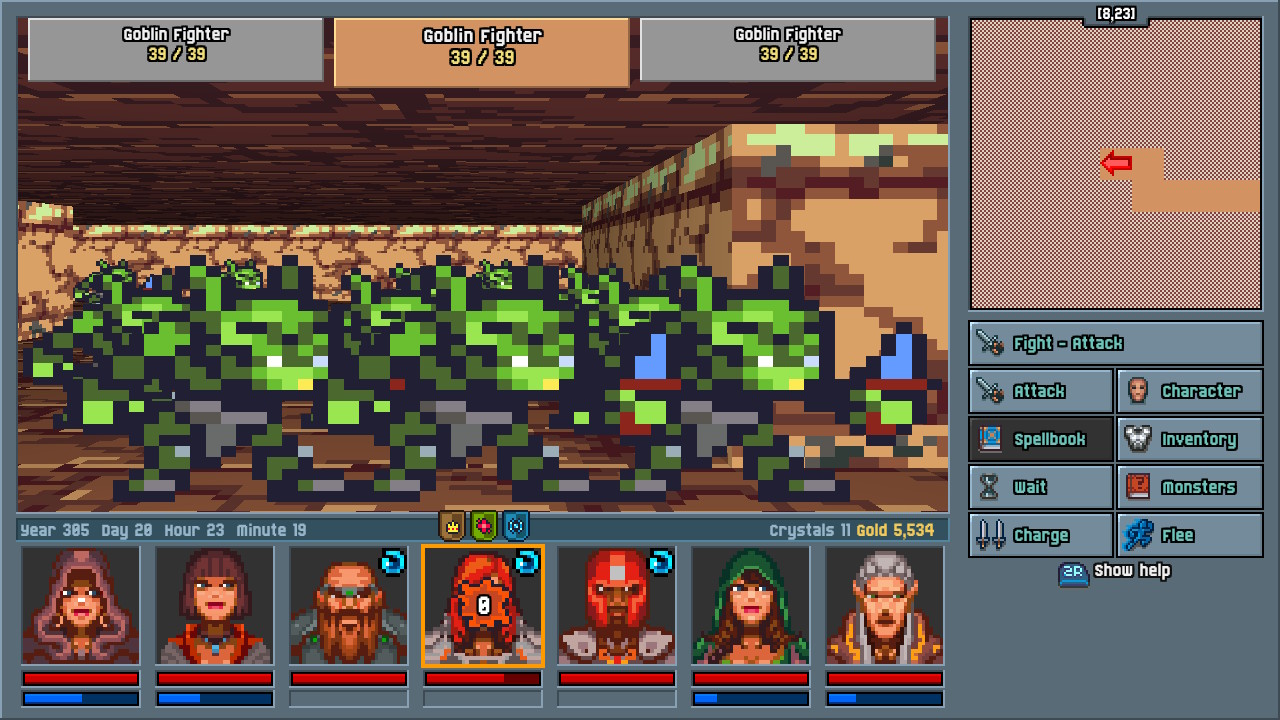
Virtually all derived stats that matter in the game scale with level. Each character gains a certain amount of HP per level based upon class, and even HP gained through Toughness seem to scale based upon level. You gain more character points to spend upon things like Toughness every three levels. Even the damage reduction you have from armor increases with levels.
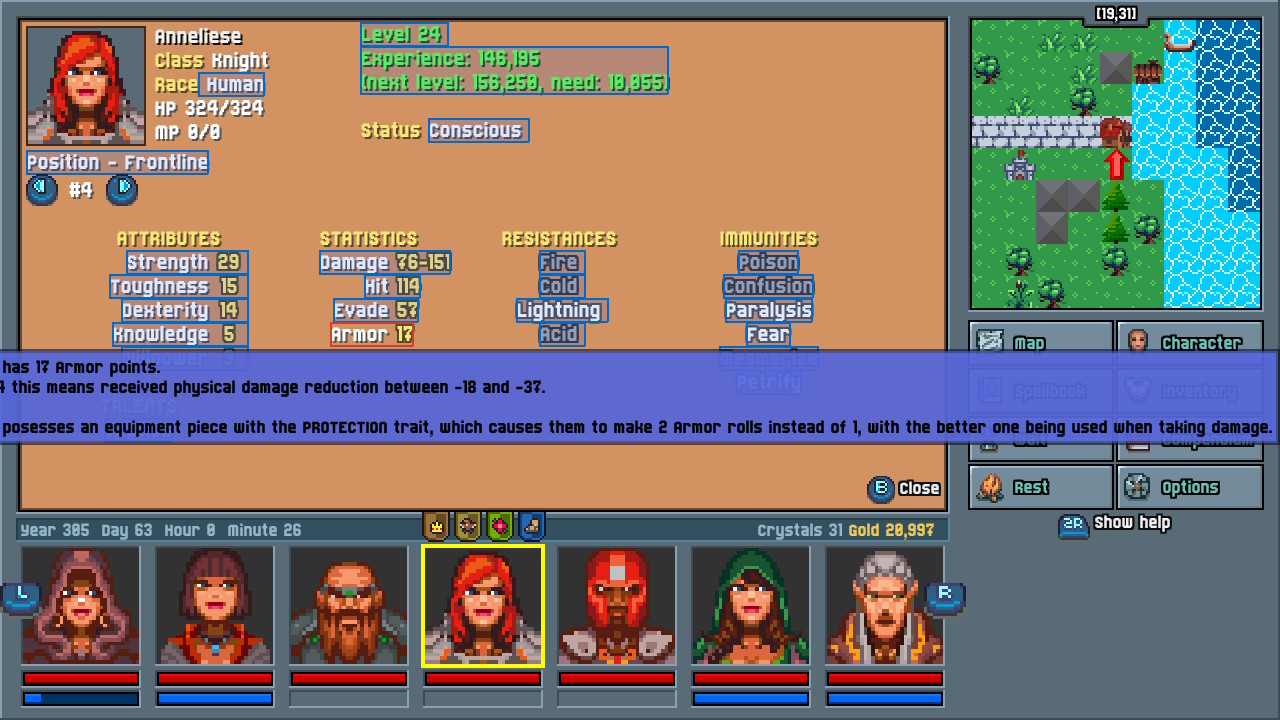
One notable feature of the game is the encumbrance system, which allows you to carry a certain amount of weight in equipment. Wizards can carry the least and knights can carry the most. Dwarves get a bonus while elves get a penalty. This means that there is technically nothing that keeps wizards from wearing plate mail, but since it weighs twice their base encumbrance, and going over encumbrance halves their precious Arcane score they need to cast spells, it’s functionally the same as preventing wizards from having plate. That said, there are some ways to boost encumbrance, including the girdle of carrying that the game likes to tease you with.
Another interesting system is that you have abilities you can use only once per rest, you can rest anywhere you are more than 3 spaces from monsters, but you need food to rest, and have a maximum of three apples (for short rests that only recover unique abilities and some HP), or three meat (for long rests that recover MP, and is in fact one of only three ways to ever recover MP). You need to buy more food in town after using those two sets of three items. This allows for rests mid-dungeon, but keeps the player coming back to town.
It’s also worth noting that this is one of those more modern games that have zero expendables like classic games did. There are no potions or wands, you only rely upon pure character abilities to survive. You need healing spells to restore HP or resting out of battle, and either some one-use-per-rest skills or resting to restore MP, no precious ether potions to restore MP mid-battle, so you have a set amount of spells you can cast in a drag-out boss battle.
Days are tracked, but I’m not sure if they actually matter. I suspect that in harder difficulties, you can manage by just running away and taking more rests and trips to town. (Running away has no penalties and always seems to work, except if a monster occupies the tile you would run away into.)
That said, you can run into more than one enemy at a time, and they move around after every movement that you take. (You can also press “zL+Y” to wait a turn in the hopes enemies move around.) Enemies that bunch up into packs of up to three enemies at a time are obviously much more difficult than a single monster, and monsters can even jump into a battle already in progress to start attacking you, ending up with sometimes seemingly endless torrents of monsters that can drain your MP significantly.
(Slaying goblins like I’m some kind of… slayer… of goblins…)
I make it sound like all I do is mash the attack button and occasionally rest, but there are reasons to use magic. The problem is that MP is a major limiting factor, and eventually, you wind up having to choose between spending so much MP in a fight you need to return to town after every single fight or just not using magic (except to heal with the most economic basic heal spell) at all. It is possible to have some boss fights where you think strategically… but these tend to be rarer.
This is the end of my fight with one of the boss monster dragons. Note how I was out of MP on my healer, and decided to just go for MP-expensive attack magic to just try to kill the dragon before the next chance it had to launch attacks that could deal over half my characters’ HP in a single attack.
This also shows the flaw in having knights, however, as armor tends to not matter as much as raw HP when armor prevents something like 40 damage, while late-game enemies deal something like 400 damage. Also, magic attacks ignore your armor entirely, and roughly 3/4ths of late-game attacks are magic, including the attacks of the most difficult monster in the game, the beholder-like eye of morgoth.
“Open” World
The game has an “open world” in the classic sense… in that you’re dumped into a massive map with very little guidance on what to do, but with roadblocks preventing progress through the game until you complete unclear goals.
One of the first things you do is unlock the fast travel system by beating an early-game dungeon. This lets you backtrack instantly, and is extremely useful when you find the free healing spots, as this allows you to warp back and forth between the free healing spots and the towns for levelups before going straight back to the dungeons with only 30 minutes passing.
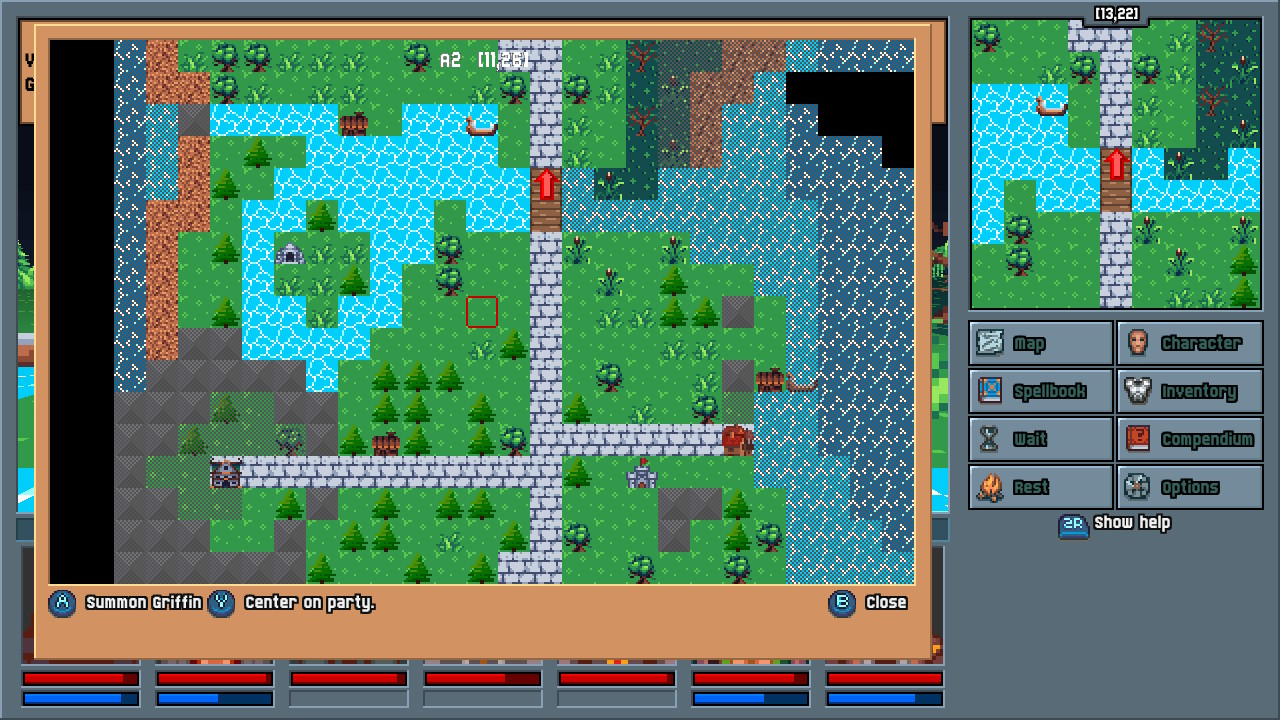
Without this, you need to spend 8 hours (and 20 gp of food) taking a long rest. This wouldn’t matter except that all buffs expire at midnight (like Cinderella), and recasting them takes considerable MP. You cannot regain MP except by free healing spots or resting for 8 hours, so it prevents you from losing that 8 hours of adventure time if you cast buffs then teleport to the free healing then teleport back to the dungeon with buffs and full MP.
The major problem with this game’s version of an “open world”, however, is that
A) it tries to be difficult.
B) scales everything so heavily by level that levels are more important than player skill.
and,
C) XP-giving monsters are finite.
Because of these three factors, you need to kill every monster you can find for that sweet, life-preserving XP in order to survive.
Enforcing the idea that you need to vacuum up all the xp you can to advance is that the game has a few natural chokepoints, in particular the desert at the south end of the map. The red scorpions there were the toughest fights in the entire game at the level I could be when I was forced to face them (I had more trouble with them than anything but some of the dragon bosses), and there was simply no progressing through the game without getting past them. (Although I suppose that technically they can be evaded by luring them away and fast-traveling to get behind them…) They are treated as common enemies, but feel like the midboss of the whole game, acting as a roadblock that forces any party with improper composition to restart before going further.
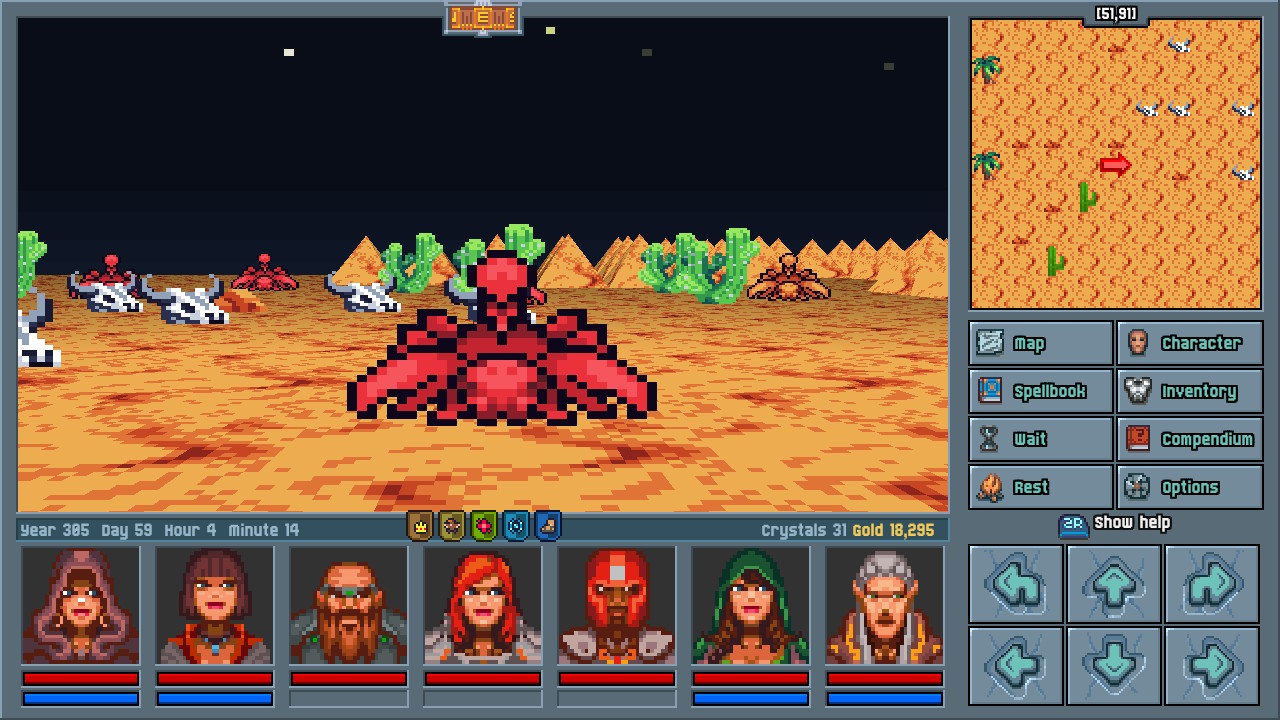
It’s notable that the first free healer is directly in front of the desert, as if the developer deliberately made it a place where you’ll need to return and heal after every fight.
Beyond even this, there are many quests that are mandatory that require you do things the quest gives offer no guidance on how to complete them. The library is a good example – to enter the library (which you need to enter the enchanted woods, which is mandatory), you need a letter from either the sage of the north or the sage of the south. No guidance on who these characters are or where they are. (And I ran across several wizards north and south of the library I thought were sages, but apparently weren’t.) When you finally find one, they want either five flowers or three rings, and give no help on finding those. Because I’d stopped even looking at treasures, I eventually found all five flowers, but I had no idea how or where, and I’d mostly forgotten that quest after a while until I was stuck and needed to remember where the stupid questgivers were again.
Random Chests and Garbage Vendors
Amberland features chests that drop loot that is randomized, as far as I can tell, when you start the game. Because chests are finite and do not respawn, this manages to basically give away the advantage that old-school games with hand-placed treasures had in being able to ensure balanced gameplay in every walkthrough while also giving away the Diablo-style of roguelite’s ability to make up for bad drops with sheer volume.
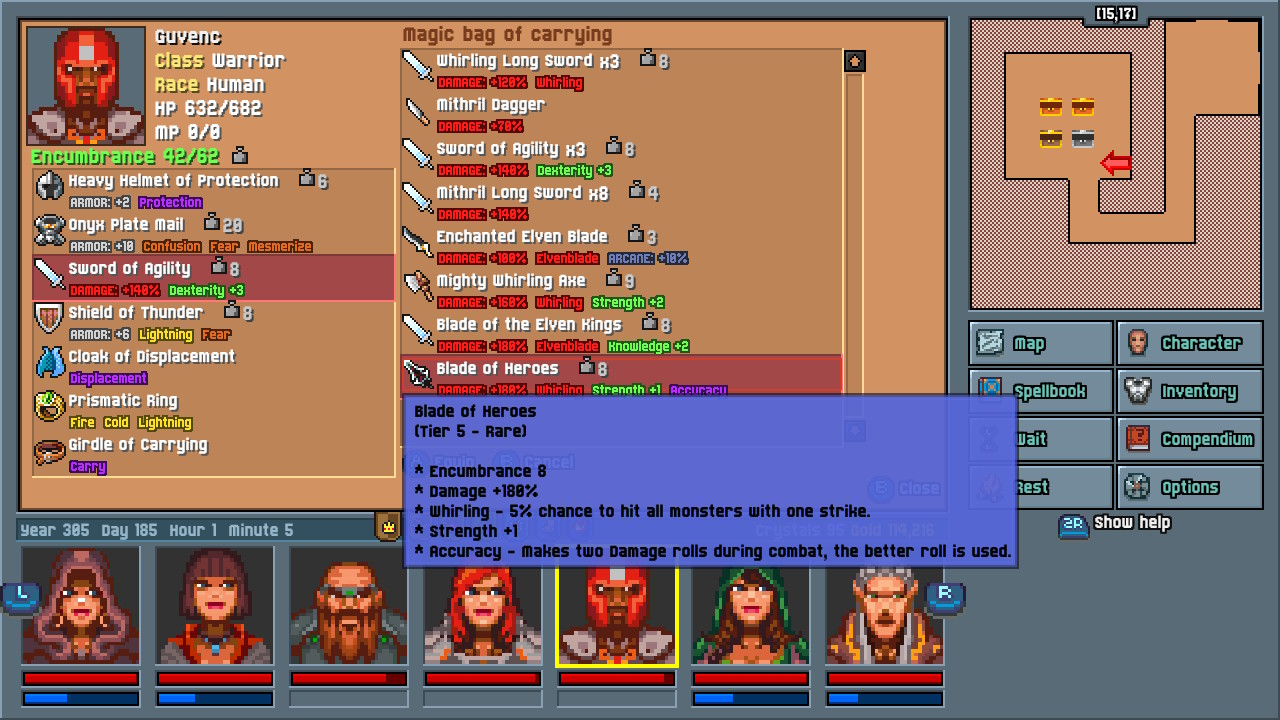
Trying the game out with a different party, I found different treasures in some of the first caves. Considering as I wore a unique hat I found in the first cave on my healer for the entire adventure, this can be significant, since there’s no guarantee that you will find items suitable for your party. (Especially the more of a given class that you have.) I also never found a better staff for my wizards than the equipment they start the game with. I’m not entirely sure other staffs even exist.
On the other hand, I found boatloads of useless “ultimate daggers”. Nobody needs daggers, the entire class of weapons is useless because they don’t raise arcane (which would make them good for mages), and they deal inferior damage in attacks (which would make them good for anybody else). Similarly, I saw some weapons like flails in stores, but never found or purchased one because they’re like longswords but heavier and worse.
Meanwhile, there are vendors.
The game features a system where you need to rescue master smiths to increase the tier of items that shops can sell you, and what they start off selling you is overpriced garbage inferior to your starting equipment. There is no guidance on where to find master smiths, so by the time you find one, you may well have already obtained equipment superior to anything that smith unlocks, anyway.
You can buy goods for prices like 4,500 gp at the start or over 100,000 gp by the end, while you’re getting 5 gp from a goblin. Quite simply, there’s enough money in the entire game to maybe buy items from the stores about half a dozen times during the entire course of the game, and you usually have better stuff by the time you can afford anything.
You might think it would be fine to sell the garbage daggers for money for the things you actually need, but they sell for about 50 gp. This was apparently done explicitly to screw players over so that they could not buy the things they needed, and to make players more dependent upon the totally random drop system.
This is an utterly terrible game system.
It results in the kind of situation you have in games like Diablo, where you get one lucky item drop that you will use for the next 3/4ths of the game while every item after it is objectively worse and has no value even as vendor trash. (And of course, as soon as you get one good item that you needed for exactly one of your characters, you will find five of them in a row…) After a while, I stopped even bothering to look at most of the garbage I was getting as “rewards” for adventuring, because it was never better than what I already had. Diablo, however, at least had the ability to let you replay the game to try to get more rolls of the dice for something with the right color-coding. This game just screws you over until you can reach the next tier of treasure chests with redundant garbage.
It is the perfect combination of systems to make treasure, the supposed reason I was going in to explore these random caves, as unrewarding and uninteresting as humanly possible. Way to make a bad system worse!
Beyond this, there are crystals and the “magic store”. The magic store is a bit of a misnomer, because the regular store sells magic stuff. The magic store, however, only trades in crystals, which are only found in tower-type dungeons on specific pedestals.
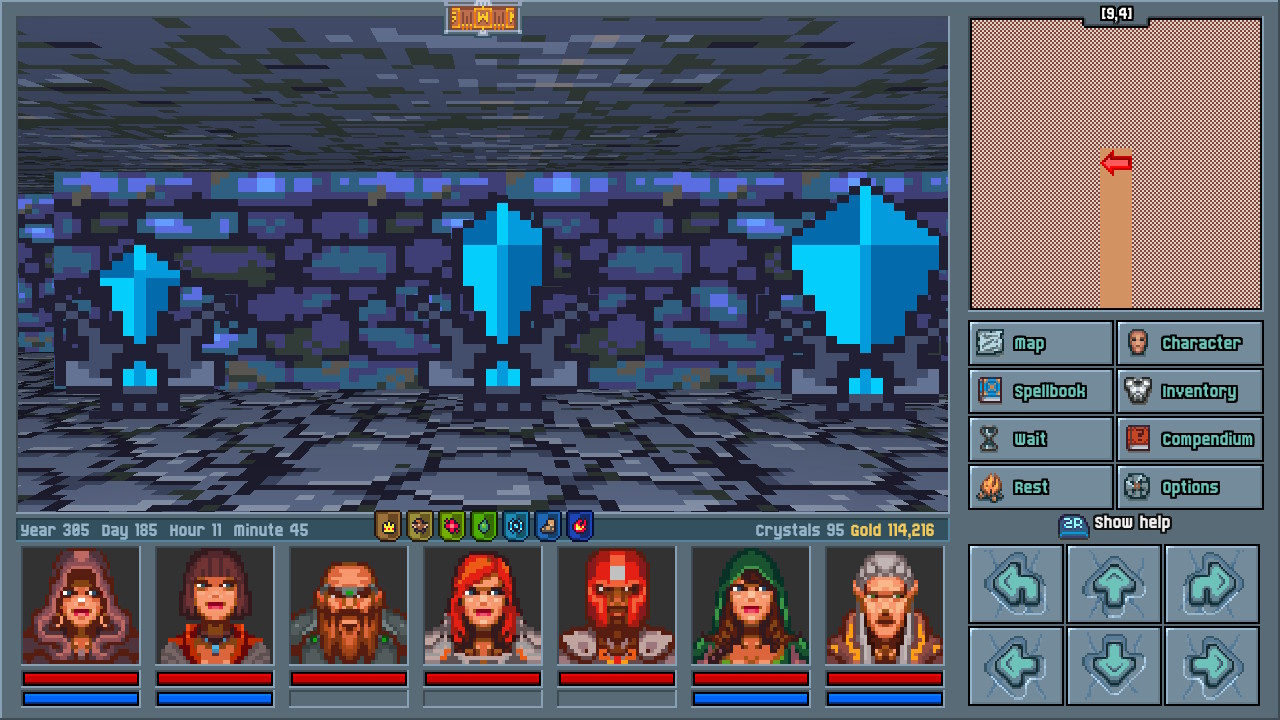
Magic stores are the more extreme version of the regular store. Those pedestals give you 1, 3, or 5 crystals at a time, you can find between 6 and 20 crystals in a whole dungeon, depending on where you are in the game, with a grand total of maybe 160 crystals in the entire game, so of course one of the first things available in the magic store is a girdle of carrying for 120 crystals. Yeah, that’s right, sucker. Save up those crystals so that you can afford that girdle once you’ve already proven you don’t need it by beating 80% of the game, already.
Again, this entire system seems designed more to taunt the player than to actually provide any actual gameplay value.
Because currency was so vanishingly rare in this game, I basically wound up never buying anything but a couple status effect protection accessories I didn’t have yet. There were a few things like cloaks that granted protection for my magic users I wanted, but I figured I’d try holding off just in case I found some in a dungeon so I’d only buy them if I really had to… and I of course wound up finding 5 of them in a dungeon. This meant that I wound up spending maybe 20% of my total currency for the entire game, and wound up doing nothing but loathing the entire economy of this game.
Many RPGs have badly-balanced economies that make gold useless, but in this game, the gold is useless because it so strictly punishes spending it for anything that you eventually learn to not even bother.
What really makes this worse is that the game already features so little variety in gameplay. I ram through dungeons killing anything that moves to the point that I forget to go to the trainer to level up sometimes. I change out my equipment so rarely (generally only when I’m going to a fire tower so I need to make sure everyone has fire resistance) that I forget what I have on after a few hours of not changing anything. I don’t even bother looking at what is in the treasure chests after a while, I’m so numbed. It’s just moving until I fill every tile in the dungeon and then rinse and repeat. Having actually varied items that you could buy or discover and compare in ways where one piece of equipment isn’t objectively better than another would actually break up the gameplay just a little bit, but instead Amberland went for the route of pure mindless monotony.
Difficulty
I played the game through on normal, as I generally do for reviewing purposes, as it is the difficulty most players will experience. Also, I didn’t have any kind of guide or knowledge about what makes a good party, so I made some sub-optimal choices that would have made the game annoying at higher difficulties.
I doubt that could be avoided, however, as the game seems to be too simple to have any real way to increase the challenge factor, and so they do what most games do and simply add damage and hit point modifiers to the monsters while making everything now so much more expensive the vendors are utterly useless… or at least, that’s how it’s supposed to work. I don’t know if it’s a bug, or there was an update that changed prices without updating the game’s instructions on what changed, but the prices are exactly the same whether you are playing noraml difficulty or insane difficulty. (The monsters have double HP, so it’s definitely a change in difficulty.) I have to wonder if it’s a bug causing all difficulties to have triple prices for everything that makes the vendors so useless…
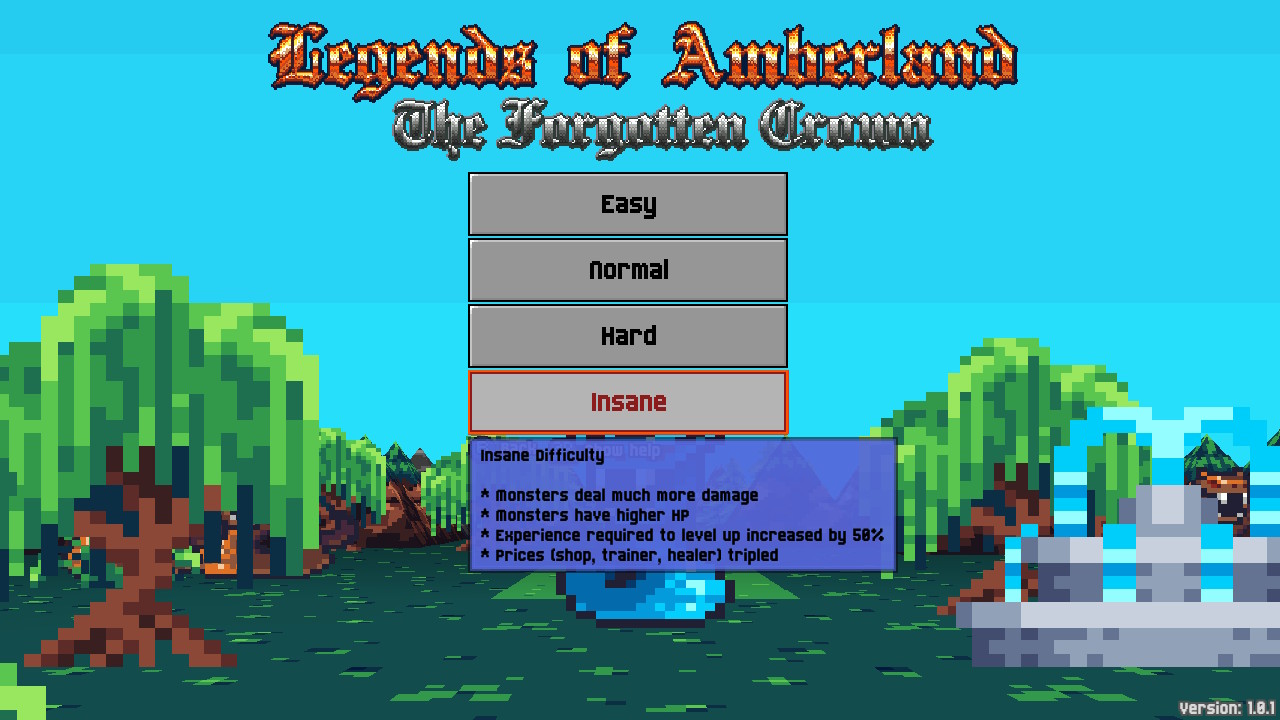
It’s telling that one of the updates required overhauling the Insane difficulty to make the late-game challenges deal less damage because boss monsters would one-shot parties at max levels.
Even without arbitrary total party kills, the higher difficulties aren’t measures of player skill, they are endurance matches where you need to use all your MP every fight before making constant trips back to town, run away from any fight with more than one elite enemy type, and generally just spend much, much longer to accomplish the same thing to create the facade of “challenge”. I’m all for games that are actually challenging to be engaging, but this is not the right way to add challenge, and it just makes the game tedious and boring.
Mapping
Special mention needs to go to mapping in this game, as the developers chose not to make mapping work like even most low-budget retro-inspired Wizardry-like games, and made mapping require literally standing on every single tile in a dungeon to map it. Since you can’t be sure you have found everything until you have a complete map, you really need to step on everything, and I wound up spending more of my brainpower on how to step efficiently to complete the map in the least number of steps than I did on fighting the monsters or anything else this game might send my way. The overworld does map things that are within 5 tiles of you, but it is shaded out and unavailable for fast travel unless you move into them.
This is notable because every step on the overworld is 10 minutes, while every step in a location like a cave or dungeon is 5 minutes (rather Tardis-like, these castles…), and since you have that midnight dispelling of buffs, you want to maximize time efficiency so you don’t wind up losing all your buffs mid-fight.
Because of this, I often found myself trying to waste time before fast-traveling to the free healer just after midnight to refresh buffs and top off MP by moving down rows of the map to fill in unmapped spaces of the overworld, just so that I start off a dungeon as early as possible.
Story
This game technically has one.
So, you’re apparently being asked to find a crown everyone forgot about because magic, however to do that, you need to go through a chain of completely unrelated quests involving asking multiple other people permission to do your job multiple times in a row.
The end result is that this somehow ties into the big “ogre invasion” that’s going on, which is supposedly a big threat to the starting kingdom. This is in spite of the fact that you murdered every last ogre that ever existed already, and already completed a quest for destroying the two castles the ogres controlled. This is in spite of the fact you did that at level 10, and at level 50, you can now one-shot whole armies of ogres. However, supposedly, you need this crown to summon some ancient heroes who can… fight as well as you could at a lower level, I guess?
The writing throughout the whole game simply bounces around in tone and purpose.
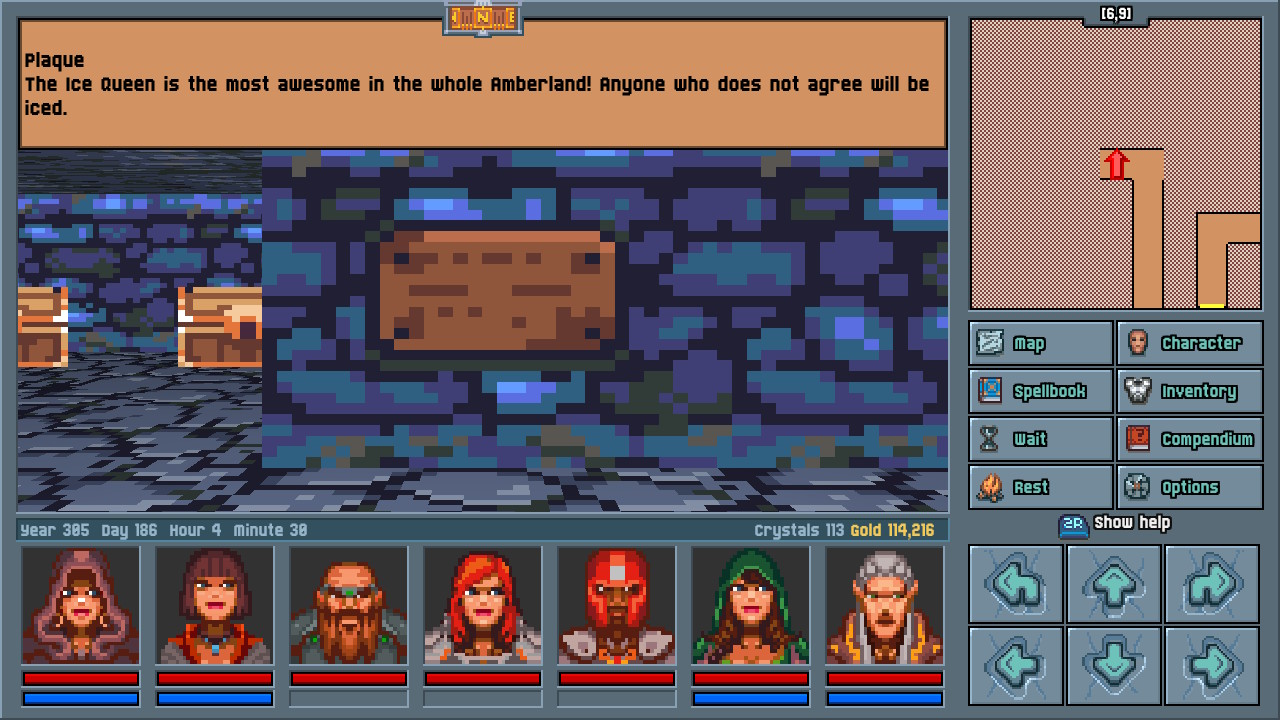
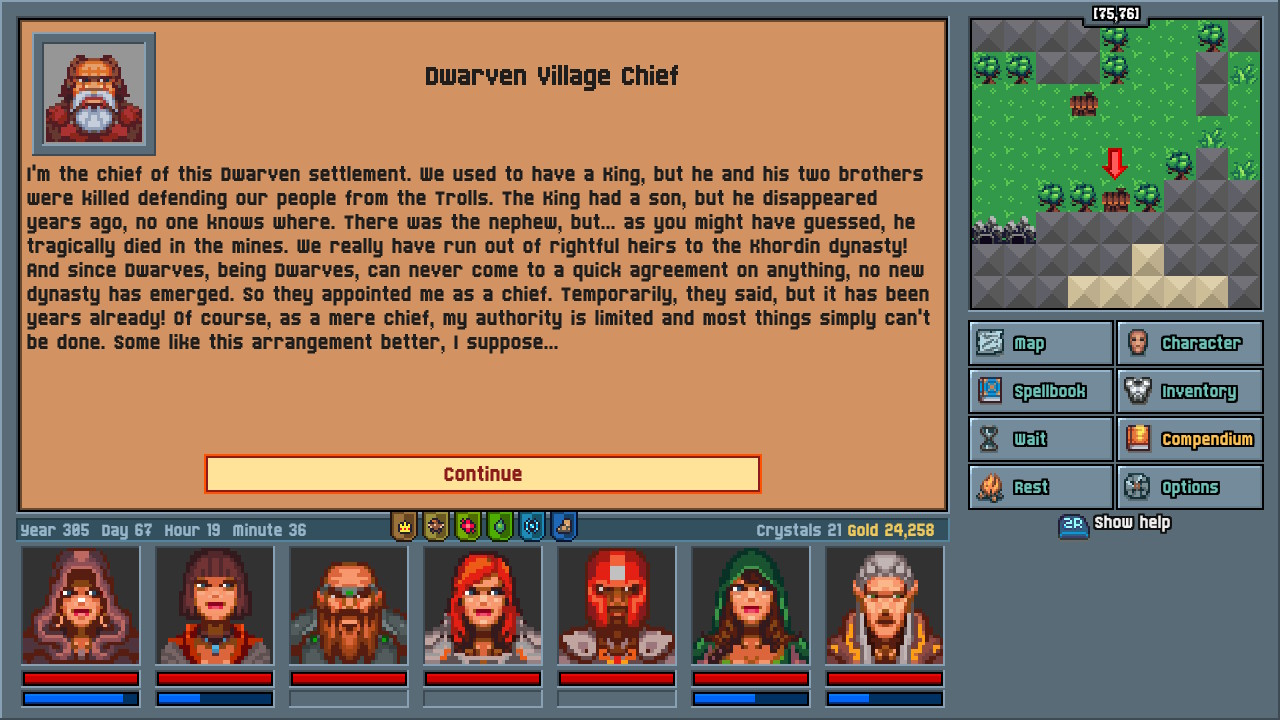
It is nearly impossible to tell what, if anything, matters by how characters talk about things.
In fact, I managed to completely miss that I was fighting the final boss of the game, and gave myself a massive anti-climax. After a dungeon I thought was a final dungeon, I had to go to a finaler-dungeon, where the first enemy I met, which looked like a generic knight monster, turned out to be the final boss. The guy not only did not have a monologue about why he started any of the events in motion, the guy didn’t even have a name, and appeared to be a generic elite warrior-type monster. I only realized he was the boss when I found the crown in the chest behind him.
Fetchquest Runaround
One of the most annoying aspects of the game is that, while some quest givers helpfully sit right outside the cave their quest is tied to, many just tell you something like “I need you to find a fountain somewhere inside one of the caves in this area.” When you find a dungeon with a fountain, it apparently doesn’t count, however, because it had to be a troll cave, not a magic cave. You get sent on a quest to find three rings that can be in chests anywhere in the entire quarter of the overworld the quest giver is located. A knight asks you to find a ring and gives no clue whatsoever where to find it, only to have it be in a hut at the literal edge of the world.
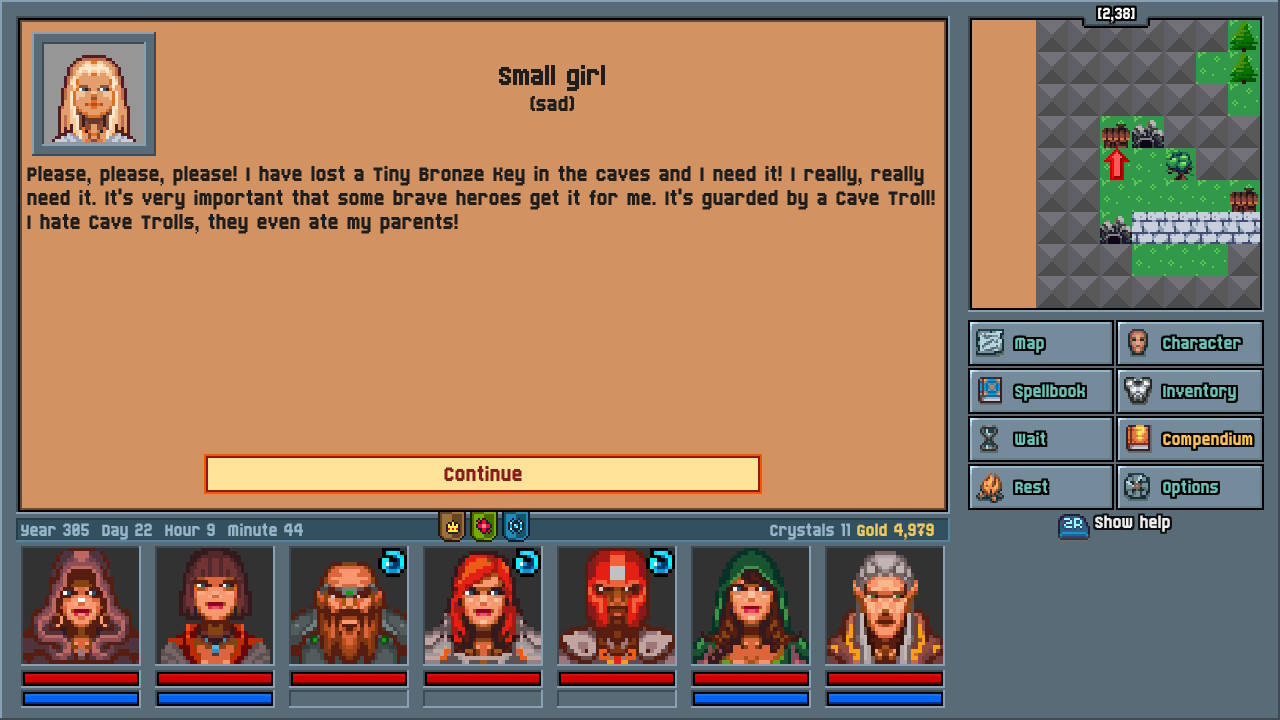
This is exacerbated by the fact that you are frequently told to do things like “get permission from every member of the wizard’s council”, when you may have only seen some of these characters once or twice at the very beginning of the game. There are no hints as to where to find some of these characters. I don’t need quest markers, but maybe having some kind of guidance on what you’re trying to do would help. At times, I was down to literally trying to go back to every single location in the entire game in order just to find some random wizard guy.
There is a “quest log”, but it gives only single sentences like “find the four wizard council members, then return” that offers zero assistance. The quest log doesn’t even count the wizards you’ve already found! In fact, many of the quests failed to update the log after completing the portion of the quest it said I should do, when I had to complete some other step that isn’t listed in the logs.
I should point out I played this game through in several days for review purposes. If you stopped playing this game for a few days and picked it back up again not remembering everything you had already done, you’d be fairly screwed and forced to backtrack just to see what could be interacted with out of every single character in the whole world several times.
Graphics
Well, you can see them in the screenshots I have. They’re more pixelated than the games they’re “inspired” by, and some creatures like spiders are unintelligible blobs of pixels, but I guess it’s just what you have to roll with when you have an indie budget.
One other thing that really annoys me, however, is that the mountains are 3D. None of the other elements of the game are treated as 3D. The map is obviously 3D with 2D icons all over it, but the types of game this one emulates used 2D arranged in ways to fake being 3D all the time, so it is real 3D that looks like the fake 3D of 80’s style games like Wizardry. The mountains, however, are real 3D pyramids, and they stand out as an eyesore… Why just the mountains? Why not make them 2D for consistency?
Sound
Turn it off.
There are about 5 tracks. One is the title song (and what was played in the trailer above), one is for all caves, one for all towers, one for castles, and one for the whole overworld. They play for about a minute or two in length before repeating, and they’re fairly generic.
That’s OK, however, because this is a game best played while listening to a podcast, or having the news on, or just turning on the radio.
The other sound effects are similarly repeated heavily. The same sound for the same regular hits, another one for crits. The death sounds for eye stalks and sorcerers are the same. All fire attacks make the same “foosh” sound, while all ice attacks make the same “shing” sound.
You don’t lose much turning off all sound.
Mobile Slave to the Grind
So after spending quite a while griping about the failings of a game that tries to laud itself as being “simplistic”, why would I still give it a fairly positive score?
Well, there’s a benefit to having a simplistic game as a mobile game, which is that you can play it when you are waiting in line, or when you’re listening to a podcast and need to engage the other 40% of your brain that gets bored from having to sit around waiting. I tend to listen to the news while playing a mobile game, and prefer a turn-based game in case I want to look up and watch some of the news instead of just listen to it.
There’s a benefit to something that’s simple and grindy, yet has a sensation that you’re advancing or completing something that takes only a small fraction of your brain, and with a game that’s this simple and repetitive, you can basically just ram through button mashing until you fill in every tile of the map.
High-speed monster slaying through button mashing.
This ability to be played when you’re bored and looking for anything to just enjoy in small bursts makes Amberland (if its quest structure gave more proper hints as to how to complete their quests) a perfect fit for the mobile market, where more “simplistic” games thrive…
… That’s why I found it staggering that this wasn’t a port from Android to Switch, but from PC to Switch. I cannot fathom why this game was released on PC first, when it really doesn’t belong on PC where it has to occupy your full brain all on its own.
Bugs and Unwinnable Games
Note from the dev: Well, it turns out there was a bug (you were the first to discover it) where you always had prices calculated as if you played on Insane difficulty regardless of selected difficulty (so those prices were indeed tripled). On both PC and Nintendo Switch (it was fixed a while ago on all platforms). Same for “incorrect combat speed on game startup” and “Girdle of Carrying encumbrance bug”. All of those were fixed. Thanks for noticing those bugs!
There are a few bugs that I noticed besides that “triple cost” one, mostly having to do with typos and the occasional quest not designed to handle handing out a quest you’ve already solved.
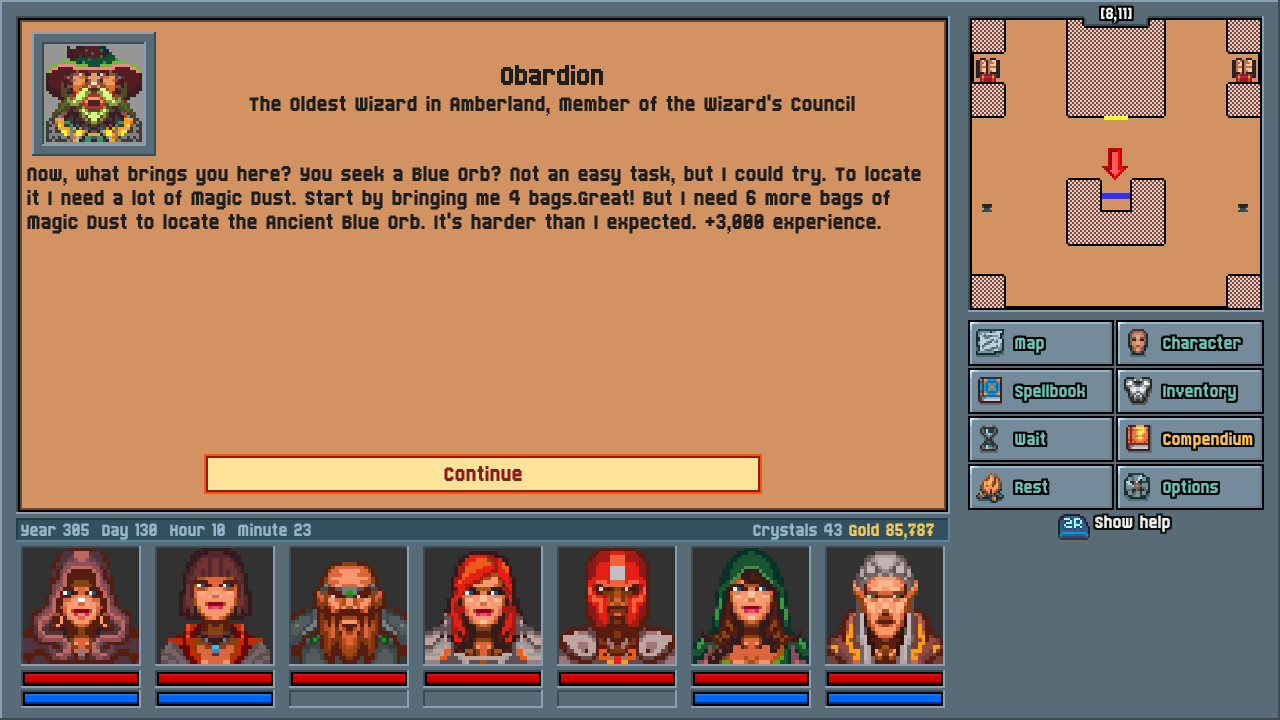
A significant and strange bug is that the game seems to run very slowly sometimes when starting a new game. By which I mean “every attack has a delay of 2 seconds between what happens and when you can do something, regardless of the game’s speed settings”. Compare this to the speed I was playing the game in the videos I posted. It’s fortunately fixable by saving, leaving the game, and loading again, but it’s bizarre.
Another much more minor problem is that wearing the girdle of carrying that increases encumbrance will keep adding 10 to your max encumbrance randomly, even though it recalculates properly whenever you change equipment. (I at one point had 41/171 encumbrance.)
A more pervasive problem, however, is that the game can be made unwinnable in certain circumstances. The most obvious (and probably forgivable… depending on your point of view) is that party composition can make winning the game impossible, especially in certain key “choke point” areas like the desert or fighting that one eye of morgoth that’s basically impossible to bypass.
A deeper design issue, however, is that the game can become unwinnable if you cannot purchase certain things you need to advance the game, such as one specific ship at the end of the desert. You can buy equipment for anything from 900 gp for basic gear to 120,000 gp for late game equipment even on normal difficulty. (Remember, it’s triple cost on the insane difficulty – you don’t even get 360,000 gp in the entire game!) You can sell that equipment back for anything from 10 gp to maybe 300 gp. There are a fixed number of monsters that never respawn, and there is absolutely no way to gain money except through combat, chests, or quests. Until you reach and unless you fast travel completely out of the way to use the free healers, every time you rest to restore MP, it takes 20 gp’s worth of food. There is no other way to restore MP but resting or the free healers. You basically constantly bleed a finite resource in this game. There really should be a backup repeatable money-making system somewhere in the game, even if it’s made boring just to prevent severe abuse.
Verdict
This is the kind of game that is hard to rate. On the one hand, you only want to rate a game on what it tries to be, not what you wish it would have been. On the other hand, there are some games that you really want to ask it if that was really all it wanted to be, and if it might not try setting its sights a little higher? For the most part, I would let it be and just give it a “SAVE”, but the raw lack of variety and in particular the badly thought-out shop system really bring the game down.
Amberland is a game of ramming into enemies and spamming out attacks until the numbers hit 0. If you’re into that, it’s as lean and streamlined an experience as you can get, and you may appreciate it as a distraction as a mobile game. For those that want games that have real depth and reward taking your time to plan your every move, you should just keep moving along.

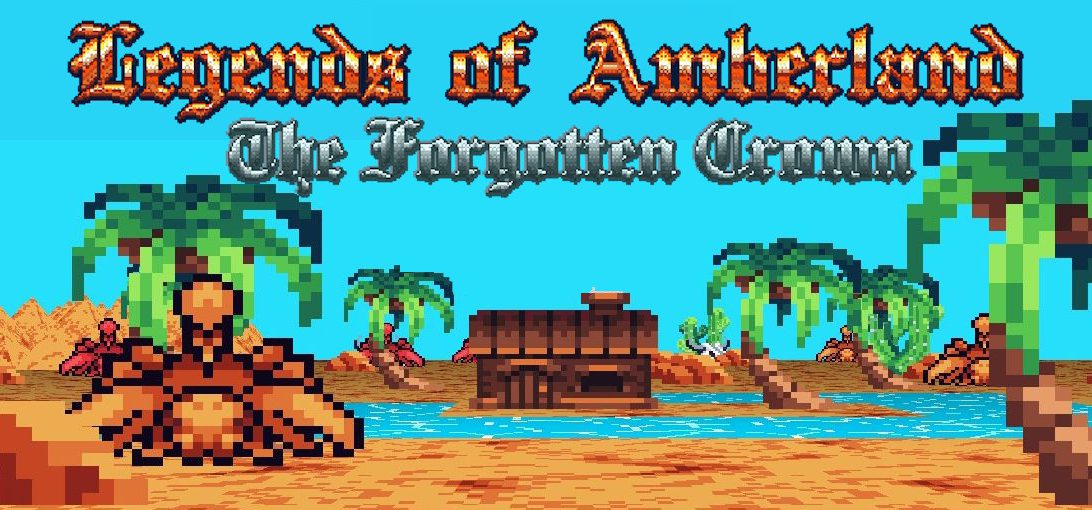

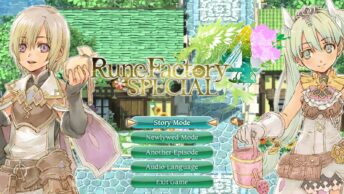
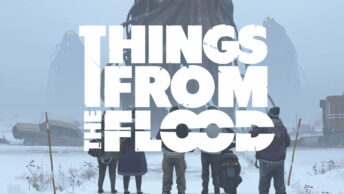
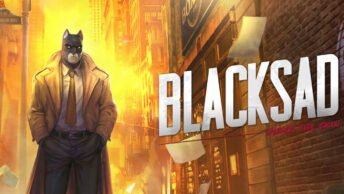
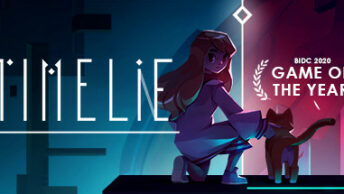




This review is just plain wrong on so many levels I won’t even get started. Sure, not liking something is valid, but clearly he did not get the whole point of this game at all. Btw, how can you take a reviewer seriously who suggests to listen to podcasts or the news while playing a game? Do yourself a favour and read the excellent RPGCodex review instead, or even the Steam or GOG reviews.